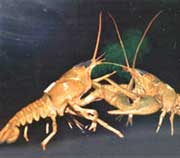Life Sciences and Chemistry
Articles and reports from the Life Sciences and chemistry area deal with applied and basic research into modern biology, chemistry and human medicine.
Valuable information can be found on a range of life sciences fields including bacteriology, biochemistry, bionics, bioinformatics, biophysics, biotechnology, genetics, geobotany, human biology, marine biology, microbiology, molecular biology, cellular biology, zoology, bioinorganic chemistry, microchemistry and environmental chemistry.

Urine trouble
A crayfish’s urine scares off its enemies.
A well-timed blast of urine is the key to winning a crayfish fight, say researchers. The chemical aggression intimidates opponents into backing down.
Ecologist Thomas Breithaupt injected freshwater crayfish with a dye that made their urine glow green. He and his colleague Petra Eger staged fights between blindfolded crayfish ( Astacus leptodactylus ), to replicate the animals’ nocturnal habits1.
The eventual

Deft diving turtle tactics
How do turtles survive long trips across the ocean? At the Society for Experimental Biology conference on Friday 12 April Ms Corinne Martin (University of Wales Swansea) will present evidence of energy-saving diving patterns adopted by green turtles to survive long ocean trips.
The turtles breed at Ascension Island, undertaking long-distance migrations greater than 2 300 km between the island and their feeding grounds on the Brazilian coast. During their trip across the ocean they don’t feed

Would you like gene chips with your salad?
The first public release of plant gene chip information is being launched at the Society for Experimental Biology conference in Swansea on Friday 12th April. Scientists from the Nottingham Arabidopsis Stock Centre (NASC), part of a multi-million pound resource network, will announce a newly accessible plant gene chip database which is available through the internet.
Unlike in GATTACA, where a drop of Ethan Hawke`s blood or an eyelash could tell you what genes he had, gene chips can tell you

Explaining Tsavo’s Maneless Man-Eaters
The phrase “king of the jungle” invariably conjures up the image of a majestic, tawny cat with a fluffy mane framing its face. But in fact not all male lions have big hair. In Kenya’s Tsavo National Park–famed for the man-eating lions that reportedly terrorized railroad workers there in the late 1800s–a number of males lack manes altogether. Exactly why this should be the case–or why any lions should have manes, for that matter–has been difficult to explain. To that end, the results of a new

Love calls from the bottom
Some men send flowers, others send chocolates. But one species of fish has a rather unusual method of seducing the opposite sex. Researchers at the Centre of Marine Science, University of Algarve, Portugal, have been studying how the peacock blenny fish secretes pheromones – chemical ‘love’ signals – from an anal gland.
Dr Eduardo Barata observed peacock blenny over the breeding season, when males occupy holes and crevices in the bottom of the sea which they use as nesting sites where female

Going Ballistic: Soft Structures Could Spell The End For Slow Shrimps
Many animals are able to rapidly extend their tongues to catch prey. In fact, the chameleon extends its tongue at an acceleration rate of 500 metres per second square – generating 5 times the G force experienced by an F-16 fighter during its most demanding maneouvre! New research presented at the Society for Experimental Biology conference in Swansea today has shed light on exactly how these remarkable feats are achieved.
Dr Johan van Leeuwen of Wageningen University, the Netherlands, sugges